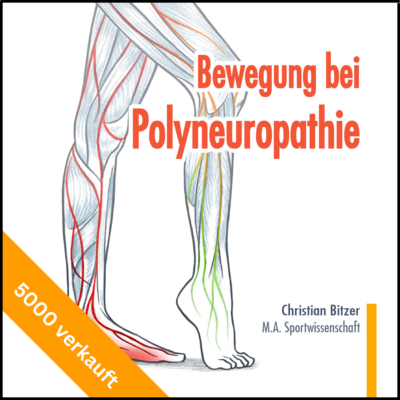Training against pain in polyneuropathy
- 18. October 20192. July 2023
- by Christian Bitzer
Pain is the worst symptom in polyneuropathy, along with insensitivity and numbness. However, recent research shows that proper exercise can help. The best part is that you can do such training for polyneuropathy-pain by yourself at home!
By the way, you can find a very detailed description of pain management in polyneuropathy here: Pain in polyneuropathy and what you can do about it.
Scientifically proven: Polyneuropathy pain gets better with exercise!
It has been known for several years that targeted exercise in polyeuropathy helps to increase balance and gait safety. Therefore, scientists as well as patients wondered for a long time: Could training also help against pain in polyneuropathy and even against numbness and loss of sensitivity? Now there are scientific studies that prove just that. I would like to present two of them in this article.
The results are clear: pain in polyneuropathy can be reduced
The studies show: Targeted training reduces Polyneuropathy symptoms. Study participants reduced uncomfrotable heat and cold sensations, as well as numbness and tingling in their hands and feet through training. The studies explicitly point out that a control group that did not train did not succeed in doing so: Training pays off! Noticeable. Therefore, scientists even tell physicians to recommend this beneficial training to their patients. This should be enough evidence for you to do it yourself. The exercises are easy and can be done at home. Here is the link to it:
Those who want the exercises handy in the form of the popular booklet, or the useful Balance Pad or even the whole Balance Set, will find everything they want here:
Too old for it?
Some patients tell me: "At my age, I don't do sports anymore!" And as a matter of fact it is not necessary to do actual sports. The exercises are not a "sport" like soccer or skiing. In fact, the exercises are so simple that virtually anyone of any age can do them at any time - and have a lot of fun doing them. Many patients also say, "At my age, it's not going to get better anymore." This is also contradicted by the first study in particular: for older participants, improvements in symptoms were even greater than for younger ones. Finally, age pays off for a change! So it's never too late for improvement.

Even better reflexes!
A second study, primarily by researchers at the Sport University of Cologne, Germany, had PNP patients undergo balance training and vibration training. Here they showed that it reduced their pain and even improved their reflexes. Balance training also has a nice advantage: you can do it at home in your own four walls. You don't need a gym, a trainer, a doctor, a physical therapist to do this. It couldn't be easier or more enjoyable.
Effort need not be - if you practice with brains
By the way, the exercises were not about trying as hard as possible. This is not about fitness training. The point is to train the nervous system, not muscles or endurance.
If you try very hard, it even leads to a small training effect. Because the nervous system can adapt better when you are recovered and can still concentrate well. It is more of a learning process than a fitness training. Because you learn new movements and especially to keep your balance better.
This causes the nervous system to adapt to the new tasks. And this adaptation leads to compensate the nerve damage that causes polyneuropathy. And this makes the pain better.
Strength and endurance training as a bonus
If you do strenuous strength and endurance training then the training is mainly directed at the muscles and the cardiovascular system. The nervous system is not in the foreground.
Polyneuropathy patients who do strength training or endurance training accordingly do not achieve great effects on the nerves. Of course, the training has very very many positive effects on the body and health. However, it alone is not enough to help against polyneuropathy. In studies in which patients with polyneuropathy completed such training, there were slight improvements, but the effect was so small that the effort was disproportionate to the benefit.
However, if you perform training for the nervous system and then add strength and endurance training, the effects complement each other and you achieve greater improvements.
The effect of training on the nervous system is improved and polyneuropathy improves faster. At the same time, strength and endurance training also works better because the better functioning nervous system results in better coordination and allows muscle strength to be used more effectively.
By the way, the effect of strength and endurance training is particularly pronounced in diabetic polyneuropathy. There are even better values for nerve conduction velocity, and more nerves seem to grow in the feet of diabetics when they exercise. Scientific studies on this can be found here: Singleton et al. (2014); Kluding et al. (2012).
Detailed exercise recommendations for diabetes and diabetic polyneuropathy can be found here: Diabetic Polyneuropathy, Exercise for Diabetics.
So, it is best for polyneuropathy patients to combine special exercises for the nervous system with strength and endurance training. However, if you only have time for one or the other, you should focus on the nervous system.
Try it for yourself
You will feel the beneficial effects of the training on your own body and in your own everyday life. So as it is as simple as that: try it! Why not try it today? It's worth it. Get started!
Sample exercises can be found here:
Those who wish are welcome to read the original study texts:
